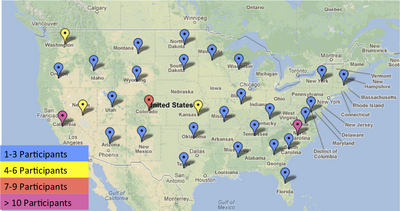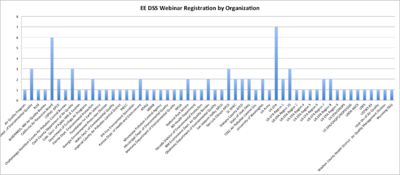Difference between revisions of "EE DSS Webinar"
| Line 22: | Line 22: | ||
*** Questions about tools? | *** Questions about tools? | ||
*** Question to States: Is there any evidence that that they have meaningful regulatory data that we don’t show in our data system? | *** Question to States: Is there any evidence that that they have meaningful regulatory data that we don’t show in our data system? | ||
| − | * Explain how to give feedback on screener tool; Feedback on Data; Workspace/community interaction ideas. | + | ** Explain how to give feedback on screener tool; Feedback on Data; Workspace/community interaction ideas. |
| − | ** Wiki discussion pages | + | *** Wiki discussion pages |
| − | ** Email and permission to transfer | + | *** Email and permission to transfer |
Revision as of 13:55, April 27, 2013
< Exceptional Air Pollution Event Analysis Community Workspace | Discussion | News | Participants | About
This series of two webinars will introduce the Exceptional Event Decision Support System (EE DSS) of which purpose is to identify and to document observations that are candidates for exceptional event flagging. The first session will be focused on screening the AQS data for exceedances above "normal" values and to indicate potential smoke or dust causes. The webinars and the associated wiki workspace are provided to give States and EPA Regions the opportunity to ask questions and provide feedback on how to improve the EE DSS. A second webinar is planned for the end of May on the same topics, incorporating feedback from State analysts and pursuing further flagging use cases.
During the first 90-minute webinar we will cover the following topics:
- Neil Frank: Introduction, Background (5 min)
- Rudy Husar: The approach of EE DSS to address the clauses required by the Exceptional Event Rule; EE DSS Video of KS Smoke Example (30 mins)
- Screening Tool - Introduce screening procedure: Exceedances... , Excess to Normal, Some context finding exceedances and those above normal variations; Showing the screening tool: PM2.5, Ozone and PM10
- How-to cases (NM, ... )
- Spatial Context
- Temporal Context
- Statistical Context
- How-to cases (NM, ... )
- Screening Tool - Introduce screening procedure: Exceedances... , Excess to Normal, Some context finding exceedances and those above normal variations; Showing the screening tool: PM2.5, Ozone and PM10
- Data and Tools to be used in Description/Documentation of Flagged Samples (20 mins)
- Suggested exceptional (dust or smoke) sources for candidate samples
- Datasets (FRM, satellite, model) and tools used in the EE DSS, link to console
- Consoles
- CATT - Transport Tool
- Erin Robinson - Explain workspace and supporting materials (5 mins)
- Adding links to EE-relevant resources
- Rudy/Erin Interaction/Feedback (Seed Questions) (30 mins?)
- Comments on rule for normal/ How do you define excess of normal?
- Questions about tools?
- Question to States: Is there any evidence that that they have meaningful regulatory data that we don’t show in our data system?
- Explain how to give feedback on screener tool; Feedback on Data; Workspace/community interaction ideas.
- Wiki discussion pages
- Email and permission to transfer
- Comments on rule for normal/ How do you define excess of normal?
The main output of this decision support effort will be a national-scale list of candidate samples (these are not "official") for EE flagging for 2010-2012. Based on this screening, States can identify and select candidate samples for EE flagging, to be submitted to EPA by the July 1, 2013 deadline. The anticipated outcomes and benefits of the EE Decision Support will include: reduction of the effort required by the States for EE flagging as well as a simpler and more uniform EE flag evaluation process by the EPA Regions.
Webinar #1 Outline
The hour and a half webinar will have three parts:
Intro
- What are exceptional events?
- Description of steps (1) state observation (2) compare to standard - Ozone (daily max), PM2.5 (daily max, yearly average), PM10 (daily max) (3) Four steps that mgmt has to consider
- We have tool set that are nationally applicable for both flag id and documentation therefore there is a decision support system that is to be applicable to any of the exceedance types, regardless of cause, pollutant, and of region.
- Identify two dates flag submission (July 1) and documentation submission (Dec. 15)
- Priority is on screening for flagging event and what is the potential cause - categories
- Intro to the EE DSS by Rudy Husar, Washington University;
EE DSS is to screen for exceedances from all four standards (those above normal variations) and identify the type of cause (by EPA category).
EE DSS
Describe steps and how EE DSS deals with them
- Exceedance
- Exceeding normal variation
- Exploration of potential causes (Dust/smoke- NAAPS; Fire pixels, wind speeds etc, console)
Use Cases
- Hands-on session to try the EE DSS for your own State;
- List of all exceedances for each of standards above normal and corresponding "high normal" value in 2012 to see how far above normal you are; cut-off for how far above normal is flexible. - to be distributed
- Compare list to NAAPS dust/smoke
- Some easily attributable
- Left over neither dust or smoke
- Wrap-up Q&A
Resources
Webinar Details and Registration
Topic: Exceptional Event Documentation Training
Host: CAPITA at Washington University, ESIP Federation AQ Workgroup
Date: Tuesday, April 30, 2013
Time: 3:00 pm, Eastern Daylight Time (New York, GMT-04:00)
Session Number: 920 523 275
To register for this training session
Go to https://esipfed.webex.com/esipfed/k2/j.php?ED=222698102&UID=1560585307&HMAC=6a9d5b20eee6a53faab07902334301cbbdf01cc1&RT=MiMxMQ%3D%3D&FM=1 and register.
Once you are approved by the host, you will receive a confirmation email with instructions for joining the session.

